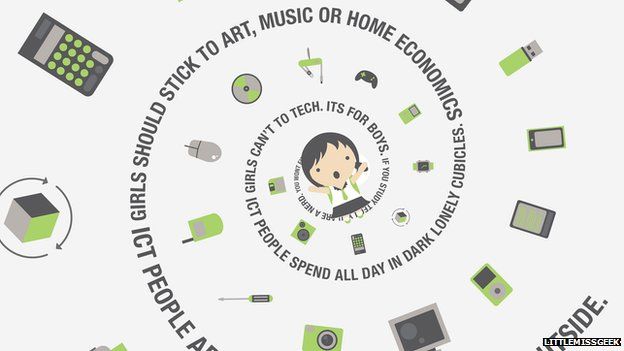Viewpoint: More women needed in technology
- Published

Walk into most tech companies and you'll be greeted by the same picture - a room made up entirely of men. You can practically smell the testosterone.
The technology industry is still struggling to shake off the image of the male, pizza-guzzling, antisocial nerd - a perception that initiatives like this month's Ada Lovelace day - which celebrates the role of women in technology - and Lady Geek's "Little Miss Geek" campaign, are striving to change.
There is no doubt that tech is overwhelmingly male.
Although women fill close to half of all jobs in the US economy, they hold less than 25% of jobs in the science and technology sector, according to a government report. In the UK, the problem is even worse: currently only 17% of jobs in the technology sector are held by women. Both numbers are declining year-on-year.
But in a world where women are buying more tech products than ever before (four in 10 are now bought by women, according to Forrester Research) why on earth should anyone care?
So long as shiny new gadgets keep flying off the shelves, what does it matter who's making them?
Serious money
It's all very well appealing to a tech chief exec's sense of social injustice - but the bottom line is that they are running a business. What do they care about gender diversity, really? We ultimately need to appeal to the thing that matters most: their wallets.
It's great that women are buying more technology than ever before, but tech companies can't sit back: they should be focusing their energy on getting the most out of this flourishing market.
The Harvard Business Review has calculated that marketing to women represents a bigger financial opportunity than India and China combined. We're talking serious money here.
That's why every chief executive should be made aware of the following stat: tech companies with more women on their management teams have a 34% higher return on investment.
The reasons are obvious. Diversity is important in any industry, but is especially relevant when it comes to technology. Tech is the way that world talks to each other. People have never emailed, liked, commented, called, messaged and tweeted more than we are doing right now. And guess what? Half of all those people are women.
The days of gadgets being boys' toys are dead as the dodo. The majority of tech products must be developed to appeal to as many people as possible, of either gender. For that, there can be no room for guesswork. Men and women must both be in the room.
It's not that we believe women are better or more effective than men - they just simply provide a different point of view, something that is vital when bringing a new product to market.
Pink it, shrink it
Examples of getting it wrong are abundant: A common 'for-the-ladies' strategy is to take last year's product, re-release it at a slightly lower-price point, slightly smaller and clad in pink plastic.
This pink it and shrink it approach represents typically shallow thinking about gender and usually only appeals to younger (lower income) women. Getting design right takes a lot more thought but yields bigger dividends.
Dr Gloria Moss, a gender marketing expert, confirms that when targeting women, having female input on the design team is crucial: "In design preference tests, I've always found extremely strong statistical evidence for 'same-sex preference'. Men tend to prefer the designs that men produce, and women prefer the designs that women produce."
In other words, it's no use burying our heads in the sand and pretending that a male-dominated team will get it right for women. Most of the time they won't.
It's time to change things. Any chief executive with half an ounce of sense should be putting their blood, sweat and tears into ensuring that the make-up of their company mirrors the make-up of their market.
It's no use blaming old-fashioned stereotypes about women not possessing the right skillsets, or simply not wanting to work in tech.
In many Eastern European countries such as Bulgaria, Estonia and Latvia - also referred to the Geek Nations' - the technology gender divide is less prevalent.
It's partly historic - during the communist era, all women were encouraged to work - but also that technology is perceived as a rewarding and well-paid career for women. If these countries can get talented women creating their tech products, then so can we.
The Little Miss Geek campaign is doing something about it - providing a 10-point practical manifesto to help tech companies attract and retain the next generation of women.
Sooner or later tech companies will wake up to the fact that getting more women through the door is imperative for business.
Those that do will reap the benefits, and the rest will be left behind, eating pizza, wondering why everyone else is making so much money.
Belinda Parmar is the author of Little Miss Geek, a book assessing the ways in which more women can become part of the technology industry. She can be followed on Twitter here, and more information about the campaign can be found here.